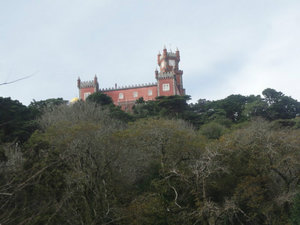Advertisement
Published: June 28th 2013

 High on a Hill
High on a Hill
As you climb or take the bus up the hill you get a glimpse of the Palacio da Pena.As promised much earlier we finally are getting the blog posting up from our side trip to Sintra when we were in Lisbon back in November 2012. Hard to believe it was that long ago, but in order to complete our journal for ourselves, we did want to be sure to include it- as they say, better late than never!
For much of the summer Lisbon is a very hot and humid place. It was also the home of the Portuguese royal family. Then, just like now when the weather gets hot and unpleasant in the cities the rich find some place cool and pleasant to stay. In Lisbon that place was Sintra. It is only 35 km (22 miles) away from central Lisbon but there is a world of difference. Sintra is quite a bit higher in altitude and is comprised of rolling hills covered with lush forest. It was the perfect place to build a little summer time hideaway from the heat, humidity and pestilence of the city. Of course, once the Royals decided this was the place to be, anyone worth their weight in gold and silver simply had to build their summer home in Sintra (keeping

 A Colorful Palace
A Colorful Palace
We found out later that the red color was used on the renovated parts of the monastery and chapel while the yellow was used for the new additions requested by King Ferdinand II. up with the Joneses you know). All of this started in the early 15th century and continued until the late 19th century when the royal family lost control of Portugal. It is now a UNESCO world heritage site which is referred to as the most romantic town in Portugal.
We originally planned on leaving Lisbon on Monday, but we extended for another night at the hotel and took off for a day to explore the historic homes of the “rich and famous”. The town contains three royal residences that you can visit, but with only a day we decided to limit our visit to two of them. The oldest, built in the early 15th century and the newest, built in the 1800’s. We had originally decided to take a bus tour from Lisbon to “do Sintra” but we found out that the full day tour doesn’t run in the winter so decided to plan it out on our own. As soon as you got off the train in Sintra you find the tourist information and can buy tickets for admission to the palaces and then catch the buses to take you up the hill to the entrance so it

 Some Details of One of the Gates
Some Details of One of the Gates
This gate incorporates the evil of the snake, the strength of the lion and cannon balls as well as the coat of arms and armored soldier.worked out well.
We first visited the Palacio da Pena (National Palace of Pena) which is known as the best example of 19
th century Portuguese Romanticism. In medieval times (12
th century) at this location a chapel was built and dedicated to Our Lady of Pena. The King in 1493 ordered a monastery to be built on the site of the chapel and it was occupied for centuries, but it suffered serious damage from the 1755 Lisbon earthquake. The religious orders were evicted from Portugal in 1834 because the monasteries and convents had become too powerful as a result of their large land holdings and great wealth. In 1838, King Ferdinand II decided to take over the now empty monastery, surrounding land and the Castle of the Moors nearby to transform it into the summer residence for the royal family. The Chapel from the 12
th century survived and was incorporated into the palace design. The German architect hired to do this was very familiar with the castles on the Rhine bringing some of these designs elements with him, however, the King and Queen Maria II added their desires to have vaulted arches, medieval and Islamic elements and designed the ornate

 Welcome Home?
Welcome Home?
One of the many entrances into the palace was this magnificent one with its Poseidon like figure holding up the window over the doorway – how would you like to be greeted by him when you came home?window for the main façade which makes for an eclectic overall design. From this high vantage point they were able to have an excellent view looking over the valley back to the city of Lisbon and the river. This palace was used by the royal family of Portugal until the early 1900’s when it was converted into a museum with UNESCO listing it as a World Heritage site in 1995.
One of the points that clearly indicated the impact of the era of Romanticism in the design of this palace was the importance put on the development of small, intimate rooms used for entertaining and for family living. There still was the large ball room typical in large palaces of the day, but it also had small dining and sitting areas that were used on a more regular basis by the family to allow for family interactions. There were also small sitting areas set up for the royal family to entertain guest on a small scale rather than in the large less intimate rooms.
The impression you get of this palace is one of being a fairy tale palace complete with a drawbridge, turrets, ramparts, battlements, domes, and
gargoyles situated high on a hill. The vibrant colors were the original colors used with the red indicating the portions that were from the original monastery and the ochre (yellow) used for the newly added sections of the palace. It was fascinating to wander around the palace as well as the expansive grounds with its gardens and think of what it must have been like to escape the summer heat in the city of Lisbon and retreat up to the hilltop and call this place your home for the summer.
The other palace we had time to visit was the Palacio de Sintra which was located in the town of Sintra itself. It’s the only fully intact medieval royal palace in Portugal. The only portion remaining from the earliest time was the chapel. This palace has been occupied by royalty almost continuously from the early 15
th century to the late 19
th century. The first reference to it however was in the 10
th century. The building took on its Gothic, Manueline and Moorish style with rebuilding done in the 15
th and 16
th century. Much of the palace however still survives from that built in the 14
th century.
With almost

 Details from Nature
Details from Nature
Everywhere you looked you saw the numerous details ordered by the King to be included in the building of his summer home –designs taken from nature such as these vines and leaves found around the windows. Tile was also incorporated into some areas such as this one.500 years difference between the 2 palaces it was amazing how different these buildings reflected the culture and the technology of their time. One of the major differences is a result of a very simple yet profound invention, the chimney and fireplace. The older palace was built before chimneys were invented. As a result it required large rooms with a central fire pit. Directly above the fireplace was a hole in the ceiling which allowed smoke to escape. Sleeping in these spaces was far more communal and as a result the royalty was not far from the servants in a palace. With the development of small chimneys and fireplaces it was possible for small private rooms to be built and heated. This meant that now the royalty could be separated from the common people. This had a profound impact on society and many believe led to the downfall of many of the monarchies in Europe.
One of the predominant features of the older palace is its 33 meter (108 ft.) high chimneys towering over the town making it quite recognizable. Both of these towers are built directly on top of the food preparation area and basically create

 Moorish Influence
Moorish Influence
The Moorish influence is clearly seen here on the patio where you can look out over the valley and see the Tagus River and Lisbon on a clear day.two large rooms with a chimney built directly above it encompassing the entire room. There was no fireplace in either of these kitchens, just a large central fire pit. This was an intermediate development and was done to reduce the chance of kitchen fires being responsible for the destruction of the entire palace.
We were not allowed to photograph the interior of this Arabic influenced palace with its decorative artwork of tiles, painting and carvings. The Coat of Arms room was added between 1515-1518 with 72 Coats of Arms of the King and other noble families of the time. Currently you see a vacant spot which had been for the Tavora family Coat of Arms but it was removed as well as all records of this family after a conspiracy against King Joseph I was discovered. Another interesting room is called the Magpie Room due to the number of paintings of magpies on the ceiling. The story goes that King John I was caught in the act of kissing a lady-in-waiting by the queen. The King believing that he was caught because of the queen overhearing gossip from the other ladies in waiting decided to put a stop to

 Over Looking the Valley
Over Looking the Valley
This view down into the valley gives an idea of how high on a hill the Palacio of Pena is situated. Due to the microclimate here many of the wealthy built summer homes to escape the heat of the city of Lisbon. the gossip by decorating the room with as many magpies as there were women in the court.
Even though we only were able to visit two of the summer palaces it was amazing the number and architectural detail of the other estates of the wealthy in town. The Manueline style is the most common of the palaces we saw which is identified by its use of maritime motifs and from nature.
We thoroughly enjoyed our visit and strongly recommend a side trip to Sintra if you are in Lisbon. It is easy to get to and it gives you a sense of what it would have been like to be royalty at the time being able to completely escape the heat and pressures of city life and live in the clean mountain air in the Sintra Mountains.
Advertisement
Tot: 0.676s; Tpl: 0.016s; cc: 36; qc: 130; dbt: 0.2885s; 1; m:domysql w:travelblog (10.17.0.13); sld: 1;
; mem: 1.5mb

























